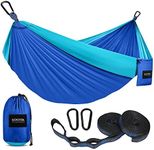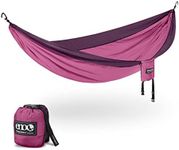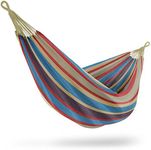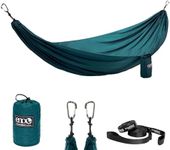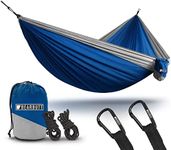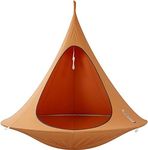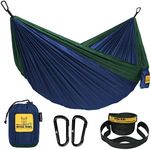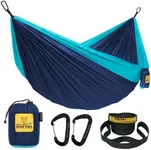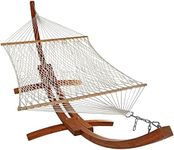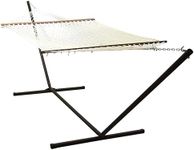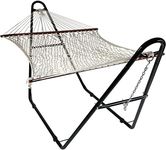Buying Guide for the Best Hammocks
Choosing the right hammock can greatly enhance your relaxation and outdoor experience. Whether you're planning to use it for camping, lounging in your backyard, or taking it on a hiking trip, there are several key factors to consider. Understanding these specifications will help you select a hammock that best fits your needs and preferences.MaterialThe material of a hammock determines its comfort, durability, and suitability for different weather conditions. Common materials include cotton, polyester, and nylon. Cotton hammocks are soft and comfortable, making them ideal for indoor use or in dry climates. Polyester hammocks are more durable and resistant to weather, making them suitable for outdoor use. Nylon hammocks are lightweight and quick-drying, perfect for camping and hiking. Choose a material based on where and how you plan to use your hammock.
SizeHammocks come in various sizes, typically categorized as single, double, or family-sized. Single hammocks are designed for one person and are lighter and more compact, making them great for solo travelers. Double hammocks can accommodate two people or provide extra space for one person, offering more comfort and versatility. Family-sized hammocks are larger and can hold multiple people, ideal for group outings or family use. Consider how many people will use the hammock and how much space you prefer.
Weight CapacityThe weight capacity of a hammock indicates the maximum weight it can safely support. This is crucial for ensuring safety and durability. Weight capacities typically range from 200 to 800 pounds. For single users, a lower capacity may suffice, but if you plan to share the hammock or use it for heavy-duty purposes, opt for a higher weight capacity. Always check the manufacturer's specifications to ensure the hammock meets your needs.
PortabilityPortability is an important factor if you plan to take your hammock on the go. This includes the hammock's weight, how compact it is when packed, and whether it comes with a carrying bag. Lightweight and compact hammocks are ideal for hiking and camping, as they are easy to carry and pack. If you plan to use the hammock primarily at home, portability may be less of a concern. Choose a hammock that balances portability with your intended use.
Suspension SystemThe suspension system includes the ropes, straps, and carabiners used to hang the hammock. A good suspension system is easy to set up, adjustable, and safe. Look for systems that include tree-friendly straps to avoid damaging trees. Some hammocks come with their own suspension systems, while others require you to purchase them separately. Consider the ease of setup and the type of environment where you'll be hanging your hammock when choosing a suspension system.
Comfort FeaturesComfort features can enhance your hammock experience. These may include built-in mosquito nets, rain tarps, or padding. Mosquito nets are essential for camping in bug-prone areas, while rain tarps provide protection from the elements. Padded hammocks offer extra comfort for extended lounging. Think about the conditions you'll be using the hammock in and what additional features might improve your comfort and convenience.
